
Q4 2018 Financial Supplement 1 1
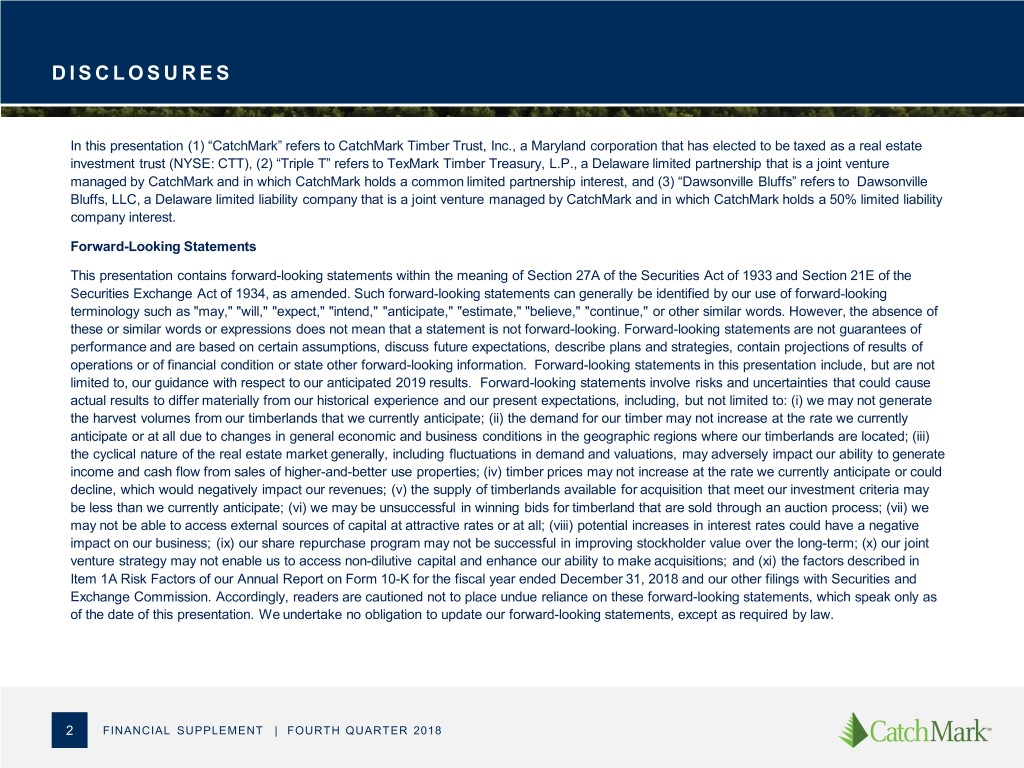
DISCLOSURES In this presentation (1) “CatchMark” refers to CatchMark Timber Trust, Inc., a Maryland corporation that has elected to be taxed as a real estate investment trust (NYSE: CTT), (2) “Triple T” refers to TexMark Timber Treasury, L.P., a Delaware limited partnership that is a joint venture managed by CatchMark and in which CatchMark holds a common limited partnership interest, and (3) “Dawsonville Bluffs” refers to Dawsonville Bluffs, LLC, a Delaware limited liability company that is a joint venture managed by CatchMark and in which CatchMark holds a 50% limited liability company interest. Forward-Looking Statements This presentation contains forward-looking statements within the meaning of Section 27A of the Securities Act of 1933 and Section 21E of the Securities Exchange Act of 1934, as amended. Such forward-looking statements can generally be identified by our use of forward-looking terminology such as "may," "will," "expect," "intend," "anticipate," "estimate," "believe," "continue," or other similar words. However, the absence of these or similar words or expressions does not mean that a statement is not forward-looking. Forward-looking statements are not guarantees of performance and are based on certain assumptions, discuss future expectations, describe plans and strategies, contain projections of results of operations or of financial condition or state other forward-looking information. Forward-looking statements in this presentation include, but are not limited to, our guidance with respect to our anticipated 2019 results. Forward-looking statements involve risks and uncertainties that could cause actual results to differ materially from our historical experience and our present expectations, including, but not limited to: (i) we may not generate the harvest volumes from our timberlands that we currently anticipate; (ii) the demand for our timber may not increase at the rate we currently anticipate or at all due to changes in general economic and business conditions in the geographic regions where our timberlands are located; (iii) the cyclical nature of the real estate market generally, including fluctuations in demand and valuations, may adversely impact our ability to generate income and cash flow from sales of higher-and-better use properties; (iv) timber prices may not increase at the rate we currently anticipate or could decline, which would negatively impact our revenues; (v) the supply of timberlands available for acquisition that meet our investment criteria may be less than we currently anticipate; (vi) we may be unsuccessful in winning bids for timberland that are sold through an auction process; (vii) we may not be able to access external sources of capital at attractive rates or at all; (viii) potential increases in interest rates could have a negative impact on our business; (ix) our share repurchase program may not be successful in improving stockholder value over the long-term; (x) our joint venture strategy may not enable us to access non-dilutive capital and enhance our ability to make acquisitions; and (xi) the factors described in Item 1A Risk Factors of our Annual Report on Form 10-K for the fiscal year ended December 31, 2018 and our other filings with Securities and Exchange Commission. Accordingly, readers are cautioned not to place undue reliance on these forward-looking statements, which speak only as of the date of this presentation. We undertake no obligation to update our forward-looking statements, except as required by law. 2 FINANCIAL SUPPLEMENT | FOURTH QUARTER 2018
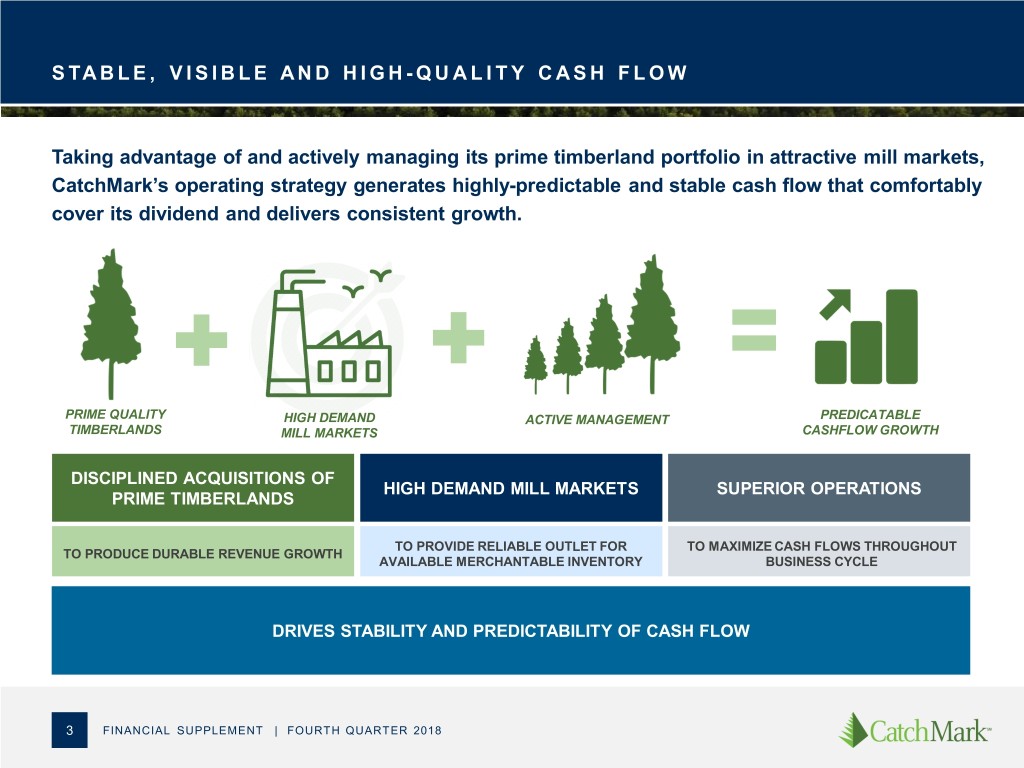
STABLE, VISIBLE AND HIGH- QUALITY CASH FLOW Taking advantage of and actively managing its prime timberland portfolio in attractive mill markets, CatchMark’s operating strategy generates highly-predictable and stable cash flow that comfortably cover its dividend and delivers consistent growth. PRIME QUALITY HIGH DEMAND ACTIVE MANAGEMENT PREDICATABLE TIMBERLANDS MILL MARKETS CASHFLOW GROWTH DISCIPLINED ACQUISITIONS OF HIGH DEMAND MILL MARKETS SUPERIOR OPERATIONS PRIME TIMBERLANDS TO PROVIDE RELIABLE OUTLET FOR TO MAXIMIZE CASH FLOWS THROUGHOUT TO PRODUCE DURABLE REVENUE GROWTH AVAILABLE MERCHANTABLE INVENTORY BUSINESS CYCLE DRIVES STABILITY AND PREDICTABILITY OF CASH FLOW 3 FINANCIAL SUPPLEMENT | FOURTH QUARTER 2018
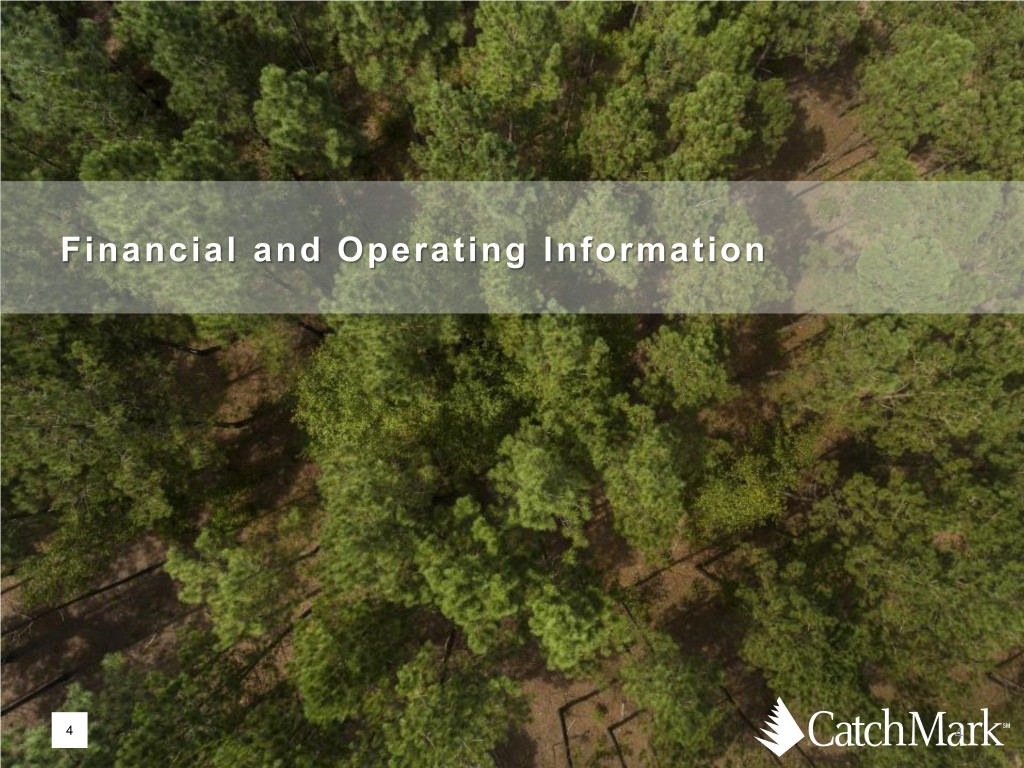
Financial and Operating Information 4 4
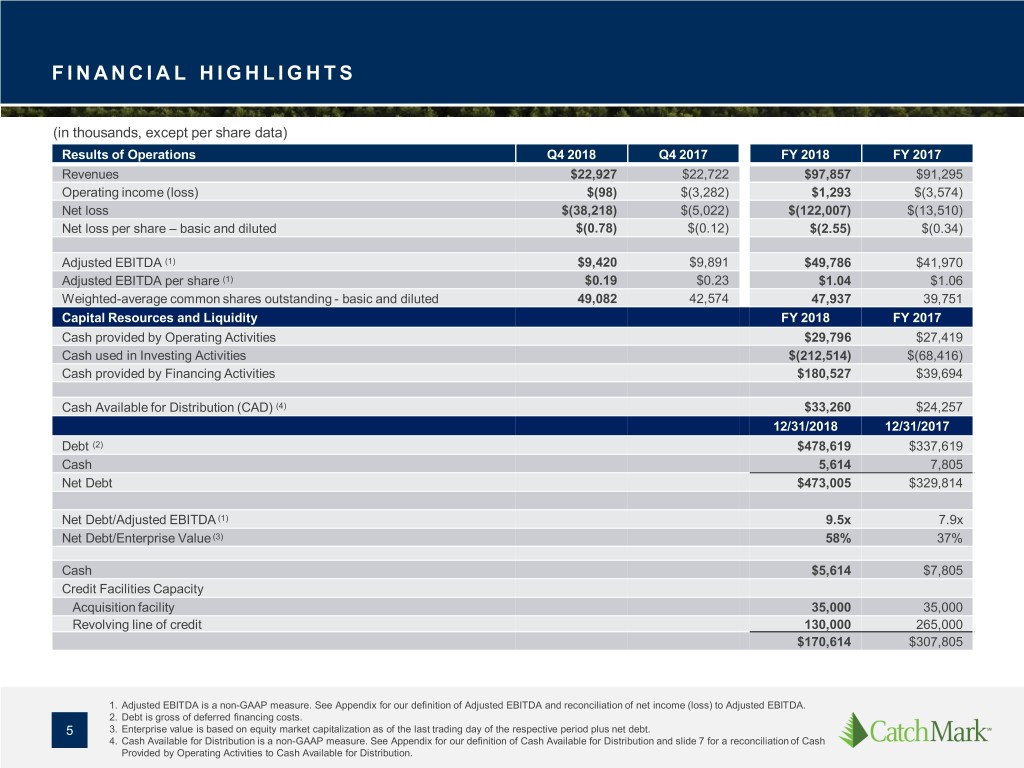
FINANCIAL HIGHLIGHTS (in thousands, except per share data) Results of Operations Q4 2018 Q4 2017 FY 2018 FY 2017 Revenues $22,927 $22,722 $97,857 $91,295 Operating income (loss) $(98) $(3,282) $1,293 $(3,574) Net loss $(38,218) $(5,022) $(122,007) $(13,510) Net loss per share – basic and diluted $(0.78) $(0.12) $(2.55) $(0.34) Adjusted EBITDA (1) $9,420 $9,891 $49,786 $41,970 Adjusted EBITDA per share (1) $0.19 $0.23 $1.04 $1.06 Weighted-average common shares outstanding - basic and diluted 49,082 42,574 47,937 39,751 Capital Resources and Liquidity FY 2018 FY 2017 Cash provided by Operating Activities $29,796 $27,419 Cash used in Investing Activities $(212,514) $(68,416) Cash provided by Financing Activities $180,527 $39,694 Cash Available for Distribution (CAD) (4) $33,260 $24,257 12/31/2018 12/31/2017 Debt (2) $478,619 $337,619 Cash 5,614 7,805 Net Debt $473,005 $329,814 Net Debt/Adjusted EBITDA (1) 9.5x 7.9x Net Debt/Enterprise Value (3) 58% 37% Cash $5,614 $7,805 Credit Facilities Capacity Acquisition facility 35,000 35,000 Revolving line of credit 130,000 265,000 $170,614 $307,805 1. Adjusted EBITDA is a non-GAAP measure. See Appendix for our definition of Adjusted EBITDA and reconciliation of net income (loss) to Adjusted EBITDA. 2. Debt is gross of deferred financing costs. 5 3. Enterprise value is based on equity market capitalization as of the last trading day of the respective period plus net debt. 4. Cash Available for Distribution is a non-GAAP measure. See Appendix for our definition of Cash Available for Distribution and slide 7 for a reconciliation of Cash Provided by Operating Activities to Cash Available for Distribution.
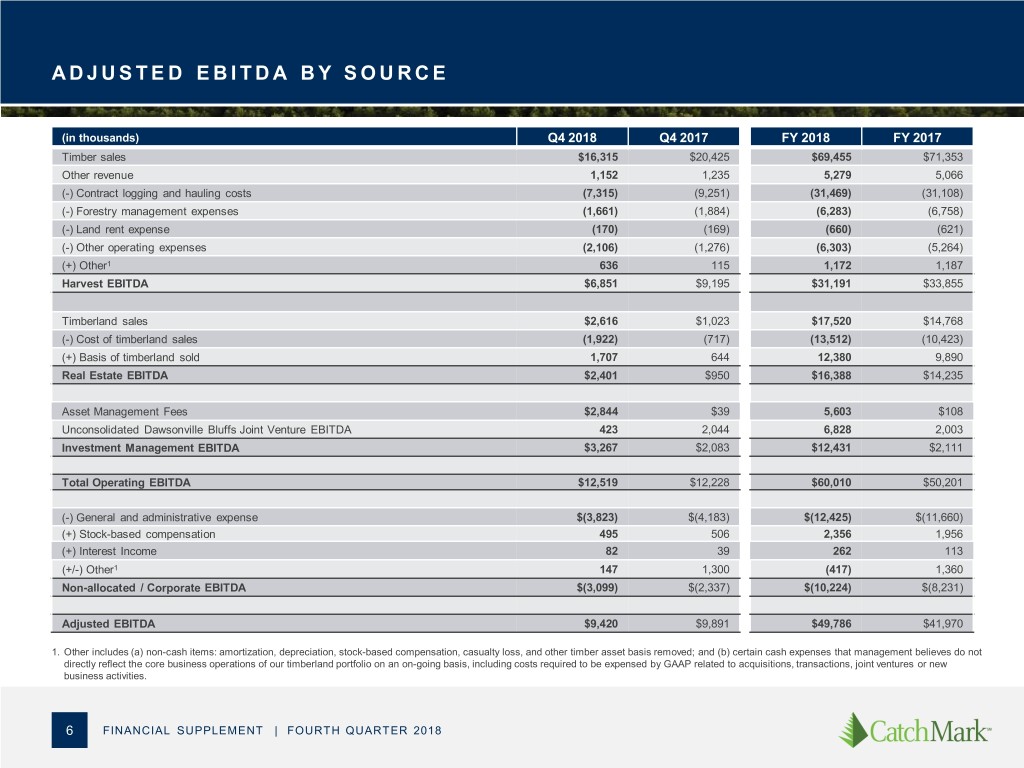
ADJUSTED EBITDA BY SOURCE (in thousands) Q4 2018 Q4 2017 FY 2018 FY 2017 Timber sales $16,315 $20,425 $69,455 $71,353 Other revenue 1,152 1,235 5,279 5,066 (-) Contract logging and hauling costs (7,315) (9,251) (31,469) (31,108) (-) Forestry management expenses (1,661) (1,884) (6,283) (6,758) (-) Land rent expense (170) (169) (660) (621) (-) Other operating expenses (2,106) (1,276) (6,303) (5,264) (+) Other1 636 115 1,172 1,187 Harvest EBITDA $6,851 $9,195 $31,191 $33,855 Timberland sales $2,616 $1,023 $17,520 $14,768 (-) Cost of timberland sales (1,922) (717) (13,512) (10,423) (+) Basis of timberland sold 1,707 644 12,380 9,890 Real Estate EBITDA $2,401 $950 $16,388 $14,235 Asset Management Fees $2,844 $39 5,603 $108 Unconsolidated Dawsonville Bluffs Joint Venture EBITDA 423 2,044 6,828 2,003 Investment Management EBITDA $3,267 $2,083 $12,431 $2,111 Total Operating EBITDA $12,519 $12,228 $60,010 $50,201 (-) General and administrative expense $(3,823) $(4,183) $(12,425) $(11,660) (+) Stock-based compensation 495 506 2,356 1,956 (+) Interest Income 82 39 262 113 (+/-) Other1 147 1,300 (417) 1,360 Non-allocated / Corporate EBITDA $(3,099) $(2,337) $(10,224) $(8,231) Adjusted EBITDA $9,420 $9,891 $49,786 $41,970 1. Other includes (a) non-cash items: amortization, depreciation, stock-based compensation, casualty loss, and other timber asset basis removed; and (b) certain cash expenses that management believes do not directly reflect the core business operations of our timberland portfolio on an on-going basis, including costs required to be expensed by GAAP related to acquisitions, transactions, joint ventures or new business activities. 6 FINANCIAL SUPPLEMENT | FOURTH QUARTER 2018
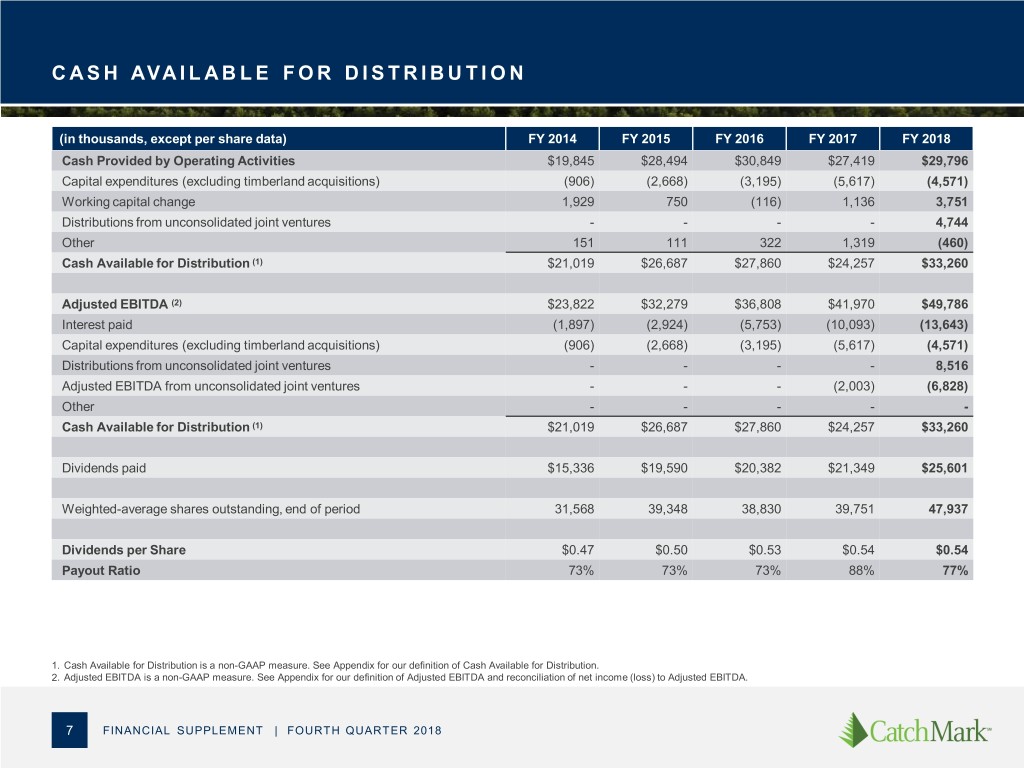
CASH AVAILABLE FOR DISTRIBUTION (in thousands, except per share data) FY 2014 FY 2015 FY 2016 FY 2017 FY 2018 Cash Provided by Operating Activities $19,845 $28,494 $30,849 $27,419 $29,796 Capital expenditures (excluding timberland acquisitions) (906) (2,668) (3,195) (5,617) (4,571) Working capital change 1,929 750 (116) 1,136 3,751 Distributions from unconsolidated joint ventures - - - - 4,744 Other 151 111 322 1,319 (460) Cash Available for Distribution (1) $21,019 $26,687 $27,860 $24,257 $33,260 Adjusted EBITDA (2) $23,822 $32,279 $36,808 $41,970 $49,786 Interest paid (1,897) (2,924) (5,753) (10,093) (13,643) Capital expenditures (excluding timberland acquisitions) (906) (2,668) (3,195) (5,617) (4,571) Distributions from unconsolidated joint ventures - - - - 8,516 Adjusted EBITDA from unconsolidated joint ventures - - - (2,003) (6,828) Other - - - - - Cash Available for Distribution (1) $21,019 $26,687 $27,860 $24,257 $33,260 Dividends paid $15,336 $19,590 $20,382 $21,349 $25,601 Weighted-average shares outstanding, end of period 31,568 39,348 38,830 39,751 47,937 Dividends per Share $0.47 $0.50 $0.53 $0.54 $0.54 Payout Ratio 73% 73% 73% 88% 77% 1. Cash Available for Distribution is a non-GAAP measure. See Appendix for our definition of Cash Available for Distribution. 2. Adjusted EBITDA is a non-GAAP measure. See Appendix for our definition of Adjusted EBITDA and reconciliation of net income (loss) to Adjusted EBITDA. 7 FINANCIAL SUPPLEMENT | FOURTH QUARTER 2018
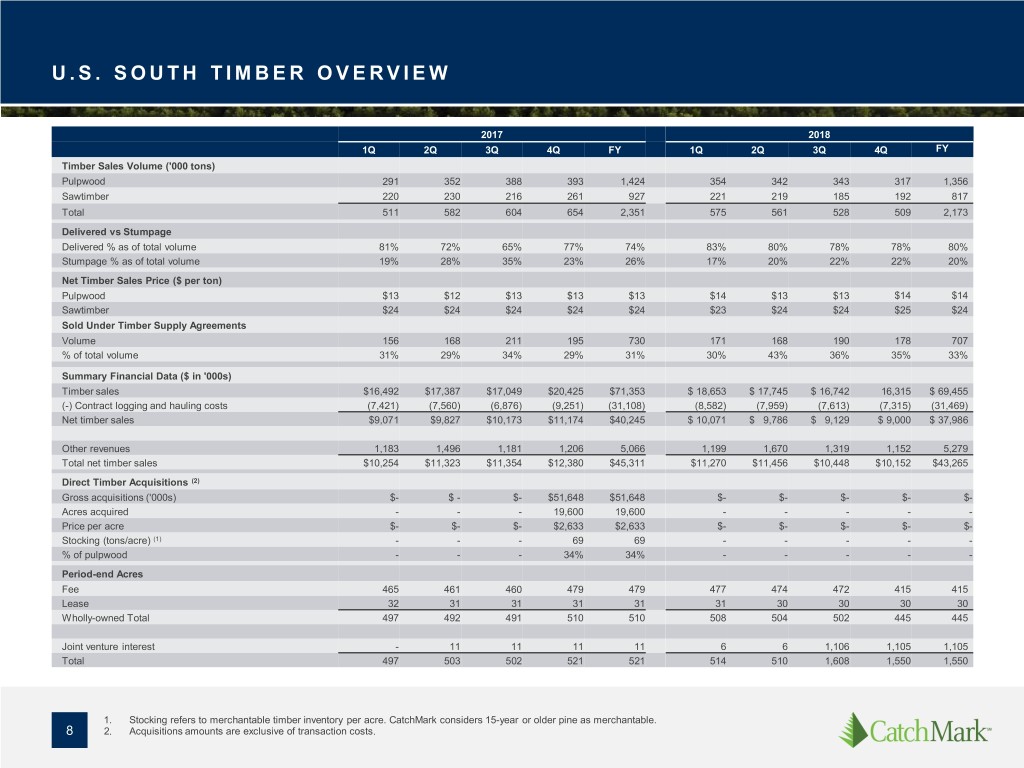
U.S. SOUTH TIMBER OVERVIEW 2017 2018 1Q 2Q 3Q 4Q FY 1Q 2Q 3Q 4Q FY Timber Sales Volume ('000 tons) Pulpwood 291 352 388 393 1,424 354 342 343 317 1,356 Sawtimber 220 230 216 261 927 221 219 185 192 817 Total 511 582 604 654 2,351 575 561 528 509 2,173 Delivered vs Stumpage Delivered % as of total volume 81% 72% 65% 77% 74% 83% 80% 78% 78% 80% Stumpage % as of total volume 19% 28% 35% 23% 26% 17% 20% 22% 22% 20% Net Timber Sales Price ($ per ton) Pulpwood $13 $12 $13 $13 $13 $14 $13 $13 $14 $14 Sawtimber $24 $24 $24 $24 $24 $23 $24 $24 $25 $24 Sold Under Timber Supply Agreements Volume 156 168 211 195 730 171 168 190 178 707 % of total volume 31% 29% 34% 29% 31% 30% 43% 36% 35% 33% Summary Financial Data ($ in '000s) Timber sales $16,492 $17,387 $17,049 $20,425 $71,353 $ 18,653 $ 17,745 $ 16,742 16,315 $ 69,455 (-) Contract logging and hauling costs (7,421) (7,560) (6,876) (9,251) (31,108) (8,582) (7,959) (7,613) (7,315) (31,469) Net timber sales $9,071 $9,827 $10,173 $11,174 $40,245 $ 10,071 $ 9,786 $ 9,129 $ 9,000 $ 37,986 Other revenues 1,183 1,496 1,181 1,206 5,066 1,199 1,670 1,319 1,152 5,279 Total net timber sales $10,254 $11,323 $11,354 $12,380 $45,311 $11,270 $11,456 $10,448 $10,152 $43,265 Direct Timber Acquisitions (2) Gross acquisitions ('000s) $- $ - $- $51,648 $51,648 $- $- $- $- $- Acres acquired - - - 19,600 19,600 - - - - - Price per acre $- $- $- $2,633 $2,633 $- $- $- $- $- Stocking (tons/acre) (1) - - - 69 69 - - - - - % of pulpwood - - - 34% 34% - - - - - Period-end Acres Fee 465 461 460 479 479 477 474 472 415 415 Lease 32 31 31 31 31 31 30 30 30 30 Wholly-owned Total 497 492 491 510 510 508 504 502 445 445 Joint venture interest - 11 11 11 11 6 6 1,106 1,105 1,105 Total 497 503 502 521 521 514 510 1,608 1,550 1,550 1. Stocking refers to merchantable timber inventory per acre. CatchMark considers 15-year or older pine as merchantable. 8 2. Acquisitions amounts are exclusive of transaction costs.
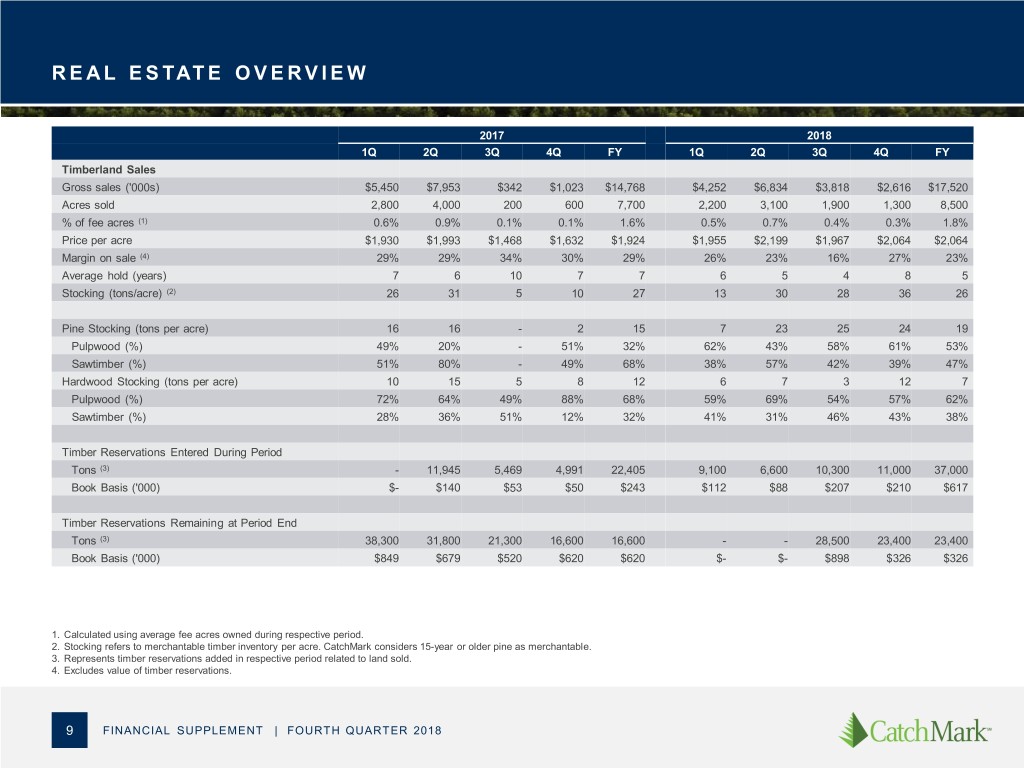
REAL ESTATE OVERVIEW 2017 2018 1Q 2Q 3Q 4Q FY 1Q 2Q 3Q 4Q FY Timberland Sales Gross sales ('000s) $5,450 $7,953 $342 $1,023 $14,768 $4,252 $6,834 $3,818 $2,616 $17,520 Acres sold 2,800 4,000 200 600 7,700 2,200 3,100 1,900 1,300 8,500 % of fee acres (1) 0.6% 0.9% 0.1% 0.1% 1.6% 0.5% 0.7% 0.4% 0.3% 1.8% Price per acre $1,930 $1,993 $1,468 $1,632 $1,924 $1,955 $2,199 $1,967 $2,064 $2,064 Margin on sale (4) 29% 29% 34% 30% 29% 26% 23% 16% 27% 23% Average hold (years) 7 6 10 7 7 6 5 4 8 5 Stocking (tons/acre) (2) 26 31 5 10 27 13 30 28 36 26 Pine Stocking (tons per acre) 16 16 - 2 15 7 23 25 24 19 Pulpwood (%) 49% 20% - 51% 32% 62% 43% 58% 61% 53% Sawtimber (%) 51% 80% - 49% 68% 38% 57% 42% 39% 47% Hardwood Stocking (tons per acre) 10 15 5 8 12 6 7 3 12 7 Pulpwood (%) 72% 64% 49% 88% 68% 59% 69% 54% 57% 62% Sawtimber (%) 28% 36% 51% 12% 32% 41% 31% 46% 43% 38% Timber Reservations Entered During Period Tons (3) - 11,945 5,469 4,991 22,405 9,100 6,600 10,300 11,000 37,000 Book Basis ('000) $- $140 $53 $50 $243 $112 $88 $207 $210 $617 Timber Reservations Remaining at Period End Tons (3) 38,300 31,800 21,300 16,600 16,600 - - 28,500 23,400 23,400 Book Basis ('000) $849 $679 $520 $620 $620 $- $- $898 $326 $326 1. Calculated using average fee acres owned during respective period. 2. Stocking refers to merchantable timber inventory per acre. CatchMark considers 15-year or older pine as merchantable. 3. Represents timber reservations added in respective period related to land sold. 4. Excludes value of timber reservations. 9 FINANCIAL SUPPLEMENT | FOURTH QUARTER 2018
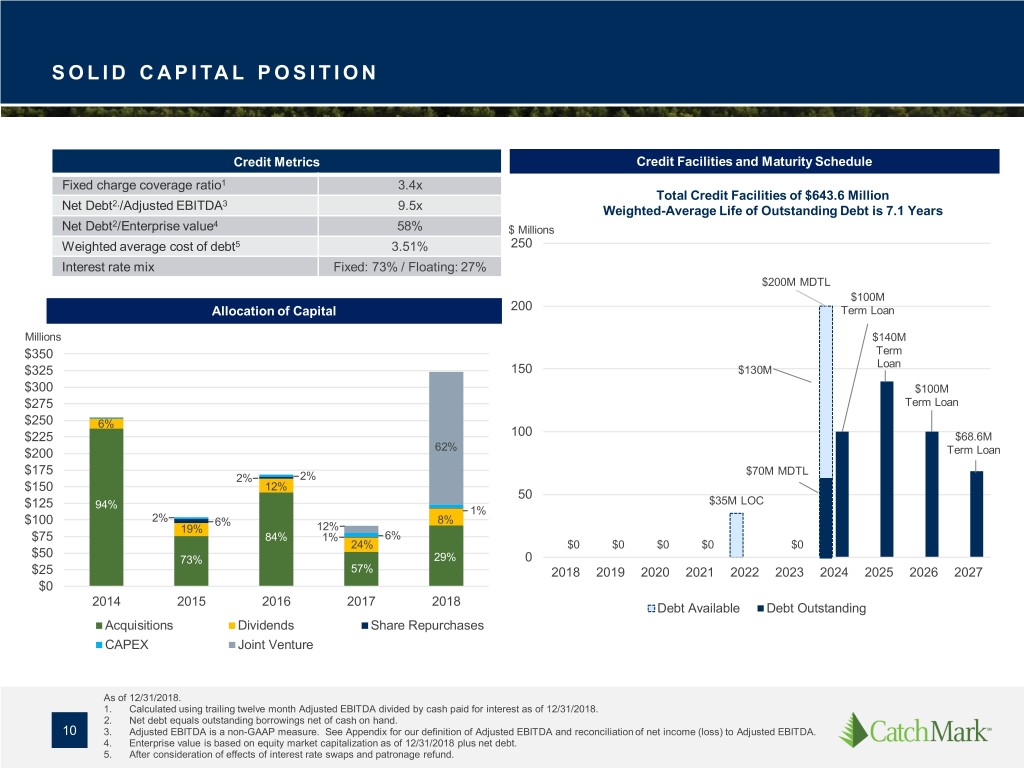
SOLID CAPITAL POSITION Credit Metrics Credit Facilities and Maturity Schedule Fixed charge coverage ratio1 3.4x Total Credit Facilities of $643.6 Million 2, 3 Net Debt /Adjusted EBITDA 9.5x Weighted-Average Life of Outstanding Debt is 7.1 Years 2 4 Net Debt /Enterprise value 58% $ Millions Weighted average cost of debt5 3.51% 250 Interest rate mix Fixed: 73% / Floating: 27% $200M MDTL $100M Allocation of Capital 200 Term Loan Millions $140M $350 Term Loan $325 150 $130M $300 $100M $275 Term Loan $250 6% $225 100 $68.6M 62% $200 Term Loan $175 $70M MDTL 2% 2% $150 12% 50 $125 94% $35M LOC 84% 1% $100 2% 6% 8% xx% 19% 12% $75 73% 84% 1% 6% 24% $0 $0 $0 $0 $0 $50 73% 29% 0 $25 57% xx% 2018 2019 2020 2021 2022 2023 2024 2025 2026 2027 $0 2014 2015 2016 2017 2018 Debt Available Debt Outstanding Acquisitions Dividends Share Repurchases CAPEX Joint Venture As of 12/31/2018. 1. Calculated using trailing twelve month Adjusted EBITDA divided by cash paid for interest as of 12/31/2018. 2. Net debt equals outstanding borrowings net of cash on hand. 10 3. Adjusted EBITDA is a non-GAAP measure. See Appendix for our definition of Adjusted EBITDA and reconciliation of net income (loss) to Adjusted EBITDA. 4. Enterprise value is based on equity market capitalization as of 12/31/2018 plus net debt. 5. After consideration of effects of interest rate swaps and patronage refund.

2019 OUTLOOK Projected Actual Change Change COMPANY GUIDANCE 2019 2018 % Harvest Volume (‘000 tons) 2,200 – 2,400 2,173 27,000 – 227,000 1% – 10% Mix - Pulpwood 50% – 60% 62% (12%) – (2%) (19)% – (3)% Mix - Sawtimber 40% – 50% 38% 2% – 12% 5% – 32% Land Sales (‘000) $16,000 – $18,000 $17,520 $(1,520) – $480 (9)% – 3% Asset Management Fees (‘000) $11,500 $5,603 $5,897 105% Net Loss (‘000)(4) $102,000 – $106,000 $(122,007) $16,007 - $20,007 (16)% – (13)% Adjusted EBITDA (‘000)(1) $52,000 – $60,000 $49,786 $2,214 – $10,214 4% – 21% Income from Unconsolidated $0 – $2,000 $2,634 $634 – $2,634 (100)% – (24)% Dawsonville Bluffs joint venture (‘000)(2) Adjusted EBITDA from unconsolidated $3,000 – $5,000 $6,829 $(3,829) – $(1,829) (56)% – (27)% Dawsonville Bluffs joint venture (‘000)(3) All numbers shown in thousands except for % change. 1. Adjusted EBITDA is a non-GAAP measure. See Appendix for our reconciliation to net income (loss). 2. Income from unconsolidated Dawsonville Bluffs joint venture represents CatchMark's 50% share and is included in CatchMark's GAAP net loss presented above. 3. Adjusted EBITDA from unconsolidated Dawsonville Bluffs joint venture represents CatchMark's 50% share, is included in CatchMark’s Adjusted EBITDA presented above and is a non-GAAP measure calculated by adding back $3M of projected basis of timberland sold to CatchMark’s income from unconsolidated Dawsonville Bluffs joint venture of $0M - $2M presented above. 4. Includes HLBV losses from the Triple T Joint Venture, which is determined based on a hypothetical liquidation of the underlying joint venture at book value as of the reporting date rather than a liquidation at fair value as of a date that is more in-line with the joint venture’s expected timing for a liquidity event. 11 FINANCIAL SUPPLEMENT | FOURTH QUARTER 2018
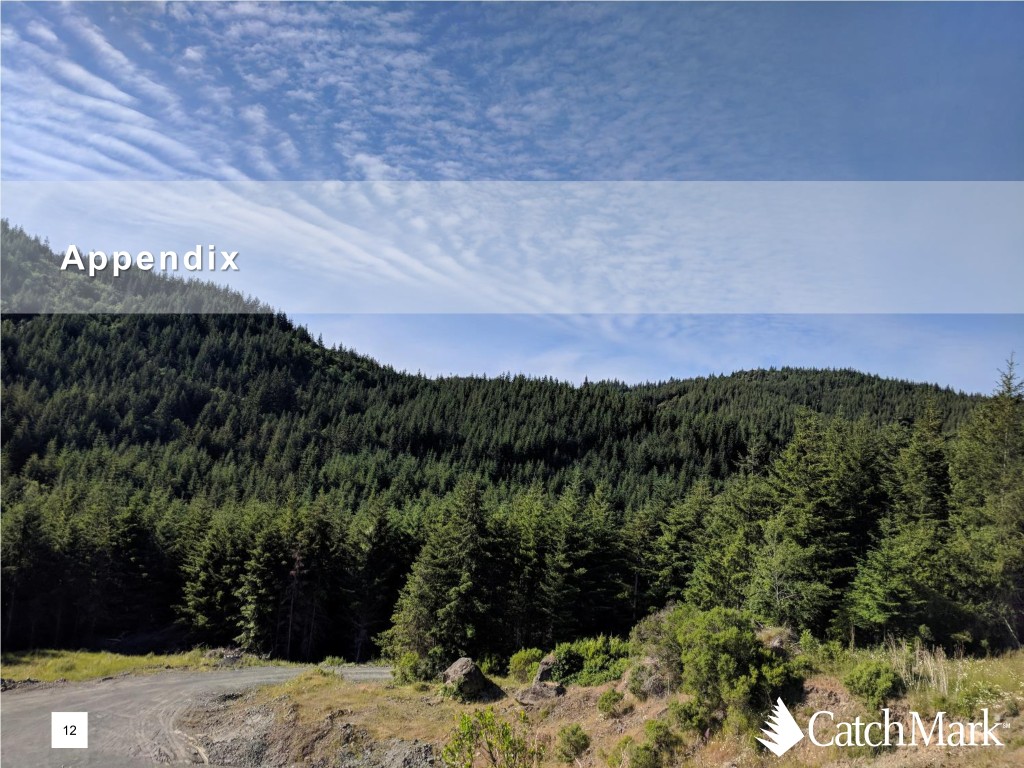
Appendix 12
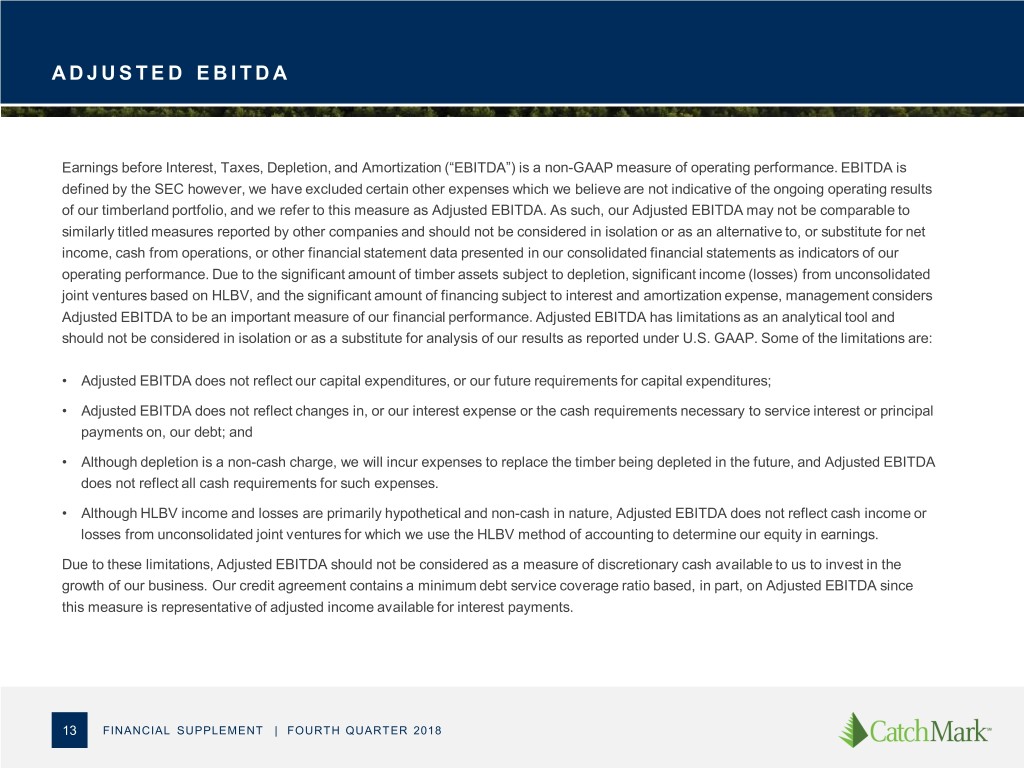
ADJUSTED EBITDA Earnings before Interest, Taxes, Depletion, and Amortization (“EBITDA”) is a non-GAAP measure of operating performance. EBITDA is defined by the SEC however, we have excluded certain other expenses which we believe are not indicative of the ongoing operating results of our timberland portfolio, and we refer to this measure as Adjusted EBITDA. As such, our Adjusted EBITDA may not be comparable to similarly titled measures reported by other companies and should not be considered in isolation or as an alternative to, or substitute for net income, cash from operations, or other financial statement data presented in our consolidated financial statements as indicators of our operating performance. Due to the significant amount of timber assets subject to depletion, significant income (losses) from unconsolidated joint ventures based on HLBV, and the significant amount of financing subject to interest and amortization expense, management considers Adjusted EBITDA to be an important measure of our financial performance. Adjusted EBITDA has limitations as an analytical tool and should not be considered in isolation or as a substitute for analysis of our results as reported under U.S. GAAP. Some of the limitations are: • Adjusted EBITDA does not reflect our capital expenditures, or our future requirements for capital expenditures; • Adjusted EBITDA does not reflect changes in, or our interest expense or the cash requirements necessary to service interest or principal payments on, our debt; and • Although depletion is a non-cash charge, we will incur expenses to replace the timber being depleted in the future, and Adjusted EBITDA does not reflect all cash requirements for such expenses. • Although HLBV income and losses are primarily hypothetical and non-cash in nature, Adjusted EBITDA does not reflect cash income or losses from unconsolidated joint ventures for which we use the HLBV method of accounting to determine our equity in earnings. Due to these limitations, Adjusted EBITDA should not be considered as a measure of discretionary cash available to us to invest in the growth of our business. Our credit agreement contains a minimum debt service coverage ratio based, in part, on Adjusted EBITDA since this measure is representative of adjusted income available for interest payments. 13 FINANCIAL SUPPLEMENT | FOURTH QUARTER 2018
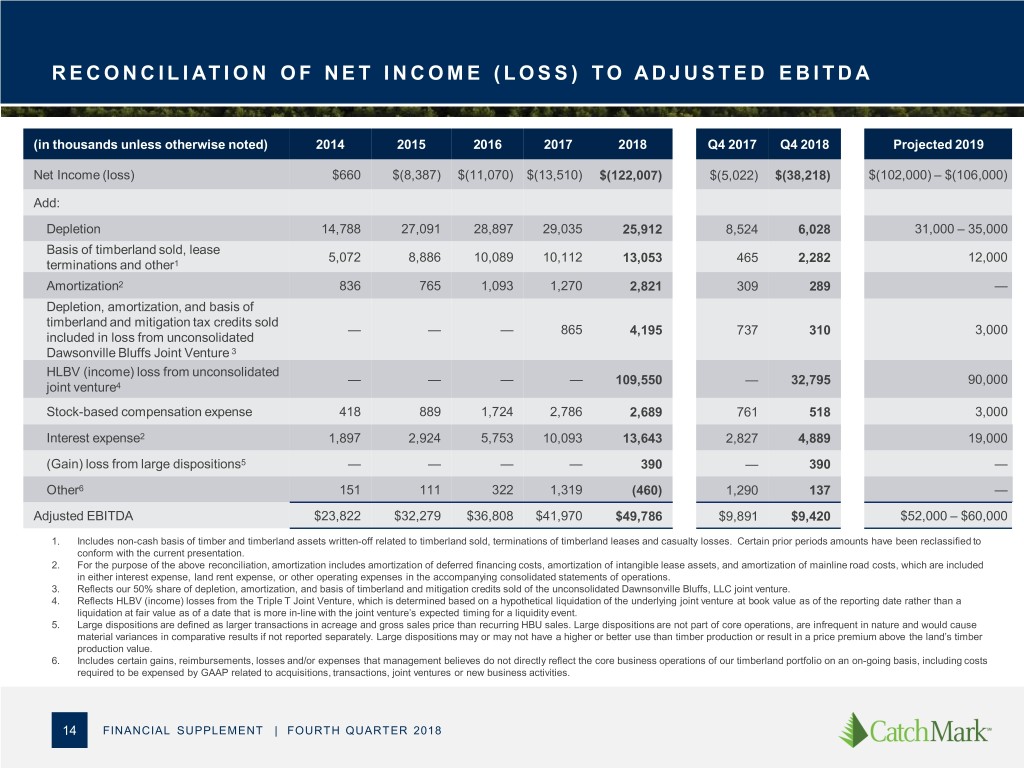
RECONCILIATION OF NET INCOME (LOSS) TO ADJUSTED EBITDA (in thousands unless otherwise noted) 2014 2015 2016 2017 2018 Q4 2017 Q4 2018 Projected 2019 Net Income (loss) $660 $(8,387) $(11,070) $(13,510) $(122,007) $(5,022) $(38,218) $(102,000) – $(106,000) Add: Depletion 14,788 27,091 28,897 29,035 25,912 8,524 6,028 31,000 – 35,000 Basis of timberland sold, lease 5,072 8,886 10,089 10,112 13,053 465 2,282 12,000 terminations and other1 Amortization2 836 765 1,093 1,270 2,821 309 289 — Depletion, amortization, and basis of timberland and mitigation tax credits sold — — — 865 4,195 737 310 3,000 included in loss from unconsolidated Dawsonville Bluffs Joint Venture 3 HLBV (income) loss from unconsolidated — — — — 109,550 — 32,795 90,000 joint venture4 Stock-based compensation expense 418 889 1,724 2,786 2,689 761 518 3,000 Interest expense2 1,897 2,924 5,753 10,093 13,643 2,827 4,889 19,000 (Gain) loss from large dispositions5 — — — — 390 — 390 — Other6 151 111 322 1,319 (460) 1,290 137 — Adjusted EBITDA $23,822 $32,279 $36,808 $41,970 $49,786 $9,891 $9,420 $52,000 – $60,000 1. Includes non-cash basis of timber and timberland assets written-off related to timberland sold, terminations of timberland leases and casualty losses. Certain prior periods amounts have been reclassified to conform with the current presentation. 2. For the purpose of the above reconciliation, amortization includes amortization of deferred financing costs, amortization of intangible lease assets, and amortization of mainline road costs, which are included in either interest expense, land rent expense, or other operating expenses in the accompanying consolidated statements of operations. 3. Reflects our 50% share of depletion, amortization, and basis of timberland and mitigation credits sold of the unconsolidated Dawnsonville Bluffs, LLC joint venture. 4. Reflects HLBV (income) losses from the Triple T Joint Venture, which is determined based on a hypothetical liquidation of the underlying joint venture at book value as of the reporting date rather than a liquidation at fair value as of a date that is more in-line with the joint venture’s expected timing for a liquidity event. 5. Large dispositions are defined as larger transactions in acreage and gross sales price than recurring HBU sales. Large dispositions are not part of core operations, are infrequent in nature and would cause material variances in comparative results if not reported separately. Large dispositions may or may not have a higher or better use than timber production or result in a price premium above the land’s timber production value. 6. Includes certain gains, reimbursements, losses and/or expenses that management believes do not directly reflect the core business operations of our timberland portfolio on an on-going basis, including costs required to be expensed by GAAP related to acquisitions, transactions, joint ventures or new business activities. 14 FINANCIAL SUPPLEMENT | FOURTH QUARTER 2018
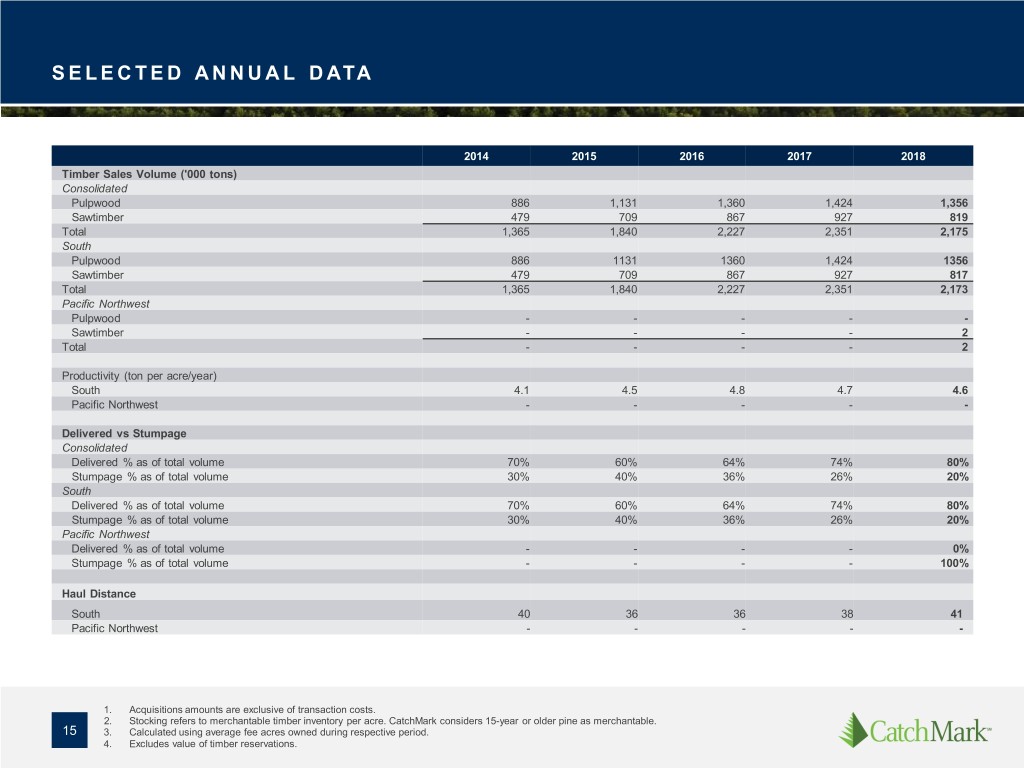
SELECTED ANNUAL DATA 2014 2015 2016 2017 2018 Timber Sales Volume ('000 tons) Consolidated Pulpwood 886 1,131 1,360 1,424 1,356 Sawtimber 479 709 867 927 819 Total 1,365 1,840 2,227 2,351 2,175 South Pulpwood 886 1131 1360 1,424 1356 Sawtimber 479 709 867 927 817 Total 1,365 1,840 2,227 2,351 2,173 Pacific Northwest Pulpwood - - - - - Sawtimber - - - - 2 Total - - - - 2 Productivity (ton per acre/year) South 4.1 4.5 4.8 4.7 4.6 Pacific Northwest - - - - - Delivered vs Stumpage Consolidated Delivered % as of total volume 70% 60% 64% 74% 80% Stumpage % as of total volume 30% 40% 36% 26% 20% South Delivered % as of total volume 70% 60% 64% 74% 80% Stumpage % as of total volume 30% 40% 36% 26% 20% Pacific Northwest Delivered % as of total volume - - - - 0% Stumpage % as of total volume - - - - 100% Haul Distance South 40 36 36 38 41 Pacific Northwest - - - - - 1. Acquisitions amounts are exclusive of transaction costs. 2. Stocking refers to merchantable timber inventory per acre. CatchMark considers 15-year or older pine as merchantable. 15 3. Calculated using average fee acres owned during respective period. 4. Excludes value of timber reservations.
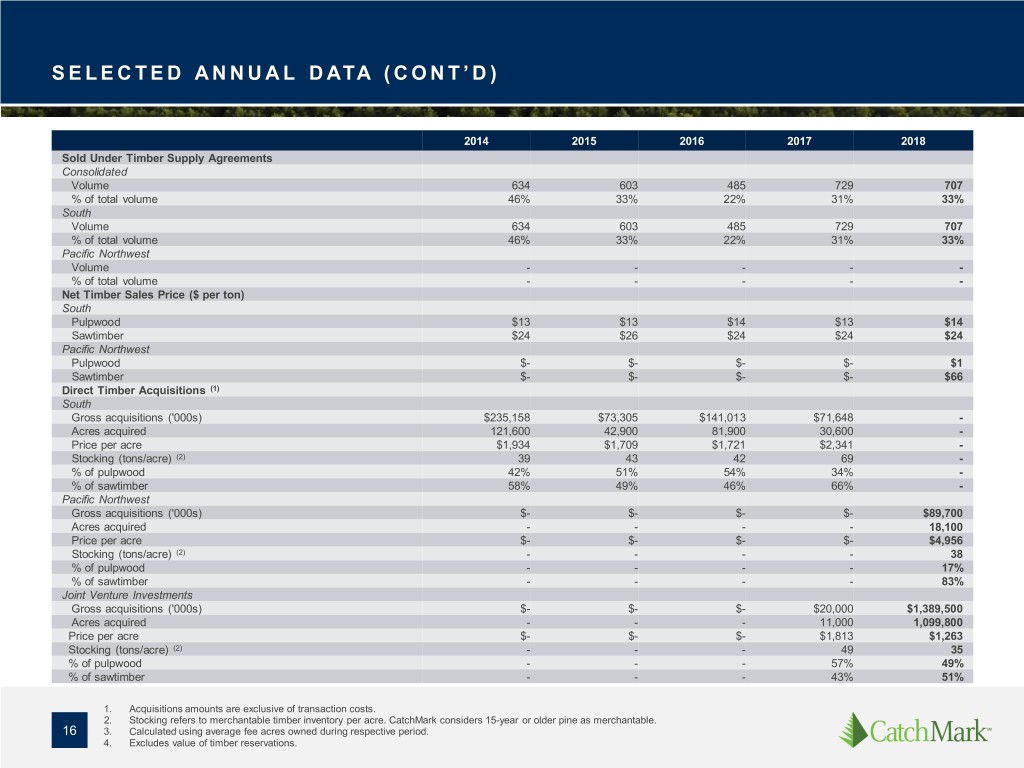
SELECTED ANNUAL DATA (CONT’D) 2014 2015 2016 2017 2018 Sold Under Timber Supply Agreements Consolidated Volume 634 603 485 729 707 % of total volume 46% 33% 22% 31% 33% South Volume 634 603 485 729 707 % of total volume 46% 33% 22% 31% 33% Pacific Northwest Volume - - - - - % of total volume - - - - - Net Timber Sales Price ($ per ton) South Pulpwood $13 $13 $14 $13 $14 Sawtimber $24 $26 $24 $24 $24 Pacific Northwest Pulpwood $- $- $- $- $1 Sawtimber $- $- $- $- $66 Direct Timber Acquisitions (1) South Gross acquisitions ('000s) $235,158 $73,305 $141,013 $71,648 - Acres acquired 121,600 42,900 81,900 30,600 - Price per acre $1,934 $1,709 $1,721 $2,341 - Stocking (tons/acre) (2) 39 43 42 69 - % of pulpwood 42% 51% 54% 34% - % of sawtimber 58% 49% 46% 66% - Pacific Northwest Gross acquisitions ('000s) $- $- $- $- $89,700 Acres acquired - - - - 18,100 Price per acre $- $- $- $- $4,956 Stocking (tons/acre) (2) - - - - 38 % of pulpwood - - - - 17% % of sawtimber - - - - 83% Joint Venture Investments Gross acquisitions ('000s) $- $- $- $20,000 $1,389,500 Acres acquired - - - 11,000 1,099,800 Price per acre $- $- $- $1,813 $1,263 Stocking (tons/acre) (2) - - - 49 35 % of pulpwood - - - 57% 49% % of sawtimber - - - 43% 51% 1. Acquisitions amounts are exclusive of transaction costs. 2. Stocking refers to merchantable timber inventory per acre. CatchMark considers 15-year or older pine as merchantable. 16 3. Calculated using average fee acres owned during respective period. 4. Excludes value of timber reservations.
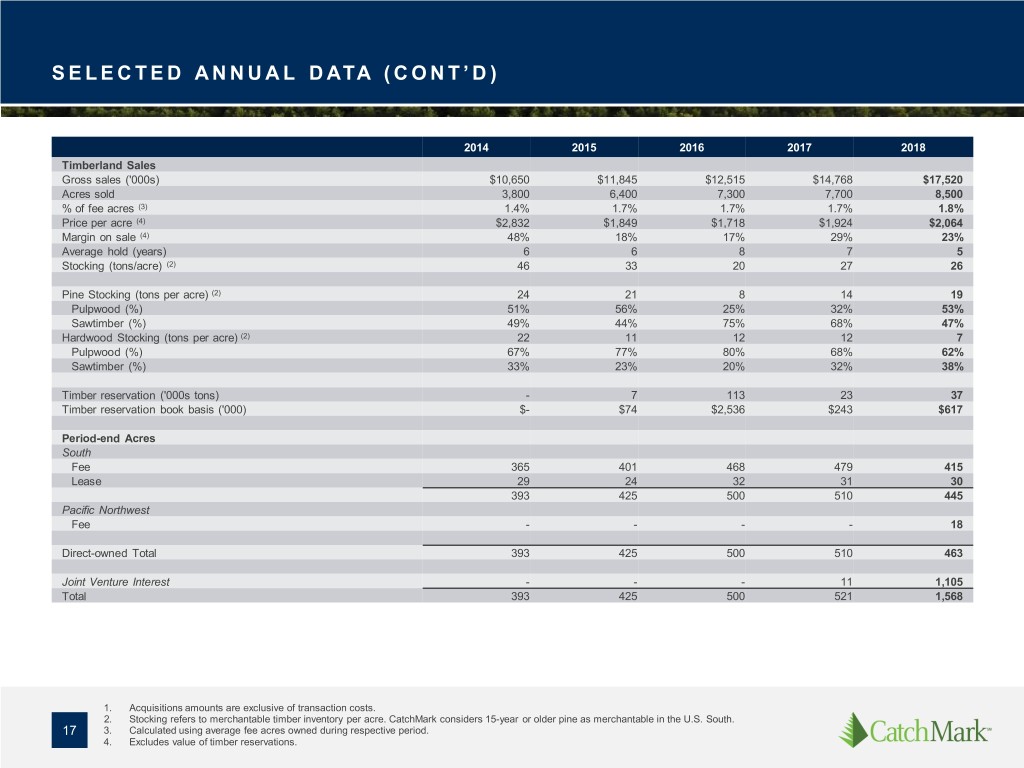
SELECTED ANNUAL DATA (CONT’D) 2014 2015 2016 2017 2018 Timberland Sales Gross sales ('000s) $10,650 $11,845 $12,515 $14,768 $17,520 Acres sold 3,800 6,400 7,300 7,700 8,500 % of fee acres (3) 1.4% 1.7% 1.7% 1.7% 1.8% Price per acre (4) $2,832 $1,849 $1,718 $1,924 $2,064 Margin on sale (4) 48% 18% 17% 29% 23% Average hold (years) 6 6 8 7 5 Stocking (tons/acre) (2) 46 33 20 27 26 Pine Stocking (tons per acre) (2) 24 21 8 14 19 Pulpwood (%) 51% 56% 25% 32% 53% Sawtimber (%) 49% 44% 75% 68% 47% Hardwood Stocking (tons per acre) (2) 22 11 12 12 7 Pulpwood (%) 67% 77% 80% 68% 62% Sawtimber (%) 33% 23% 20% 32% 38% Timber reservation ('000s tons) - 7 113 23 37 Timber reservation book basis ('000) $- $74 $2,536 $243 $617 Period-end Acres South Fee 365 401 468 479 415 Lease 29 24 32 31 30 393 425 500 510 445 Pacific Northwest Fee - - - - 18 Direct-owned Total 393 425 500 510 463 Joint Venture Interest - - - 11 1,105 Total 393 425 500 521 1,568 1. Acquisitions amounts are exclusive of transaction costs. 2. Stocking refers to merchantable timber inventory per acre. CatchMark considers 15-year or older pine as merchantable in the U.S. South. 17 3. Calculated using average fee acres owned during respective period. 4. Excludes value of timber reservations.
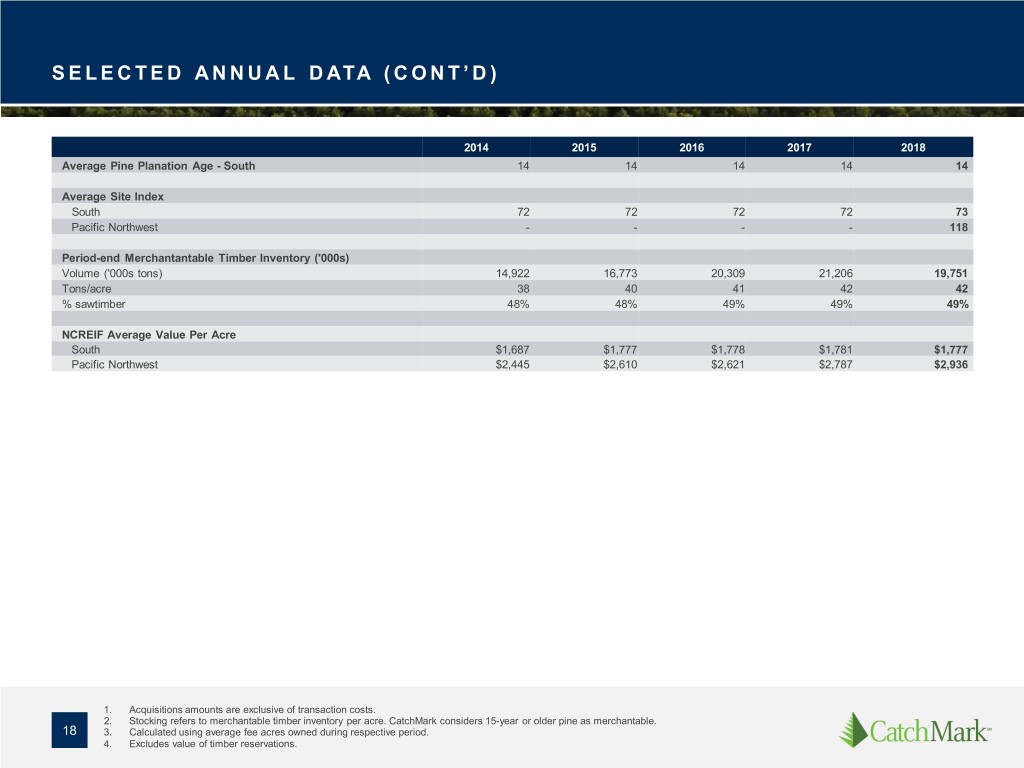
SELECTED ANNUAL DATA (CONT’D) 2014 2015 2016 2017 2018 Average Pine Planation Age - South 14 14 14 14 14 Average Site Index South 72 72 72 72 73 Pacific Northwest - - - - 118 Period-end Merchantantable Timber Inventory ('000s) Volume ('000s tons) 14,922 16,773 20,309 21,206 19,751 Tons/acre 38 40 41 42 42 % sawtimber 48% 48% 49% 49% 49% NCREIF Average Value Per Acre South $1,687 $1,777 $1,778 $1,781 $1,777 Pacific Northwest $2,445 $2,610 $2,621 $2,787 $2,936 1. Acquisitions amounts are exclusive of transaction costs. 2. Stocking refers to merchantable timber inventory per acre. CatchMark considers 15-year or older pine as merchantable. 18 3. Calculated using average fee acres owned during respective period. 4. Excludes value of timber reservations.

DEFINITIONS OF NON- GAAP MEASURES Adjusted EBITDA: Earnings before taxes, interest, depletion, amortization, non-cash cost of timberland sales, stock-based compensation expense, such amounts related to unconsolidated joint ventures, Large Dispositions and certain gains, reimbursements, losses and/or expenses that management believes do not directly reflect the core business operations of our timberland portfolio on an on-going basis, including amounts required to be expensed by GAAP related to acquisitions, transactions, joint ventures or new business activities. Cash Available for Distribution (CAD): Cash provided by operating activities adjusted for capital expenditures (excluding timberland acquisitions), working capital changes, cash distributions from unconsolidated joint ventures and certain cash expenditures that management believes do not directly reflect the core business operations of our timberland portfolio on an on-going basis, including costs required to be expensed by GAAP related to acquisitions, transactions, joint ventures or new business activities. 19 FINANCIAL SUPPLEMENT | FOURTH QUARTER 2018
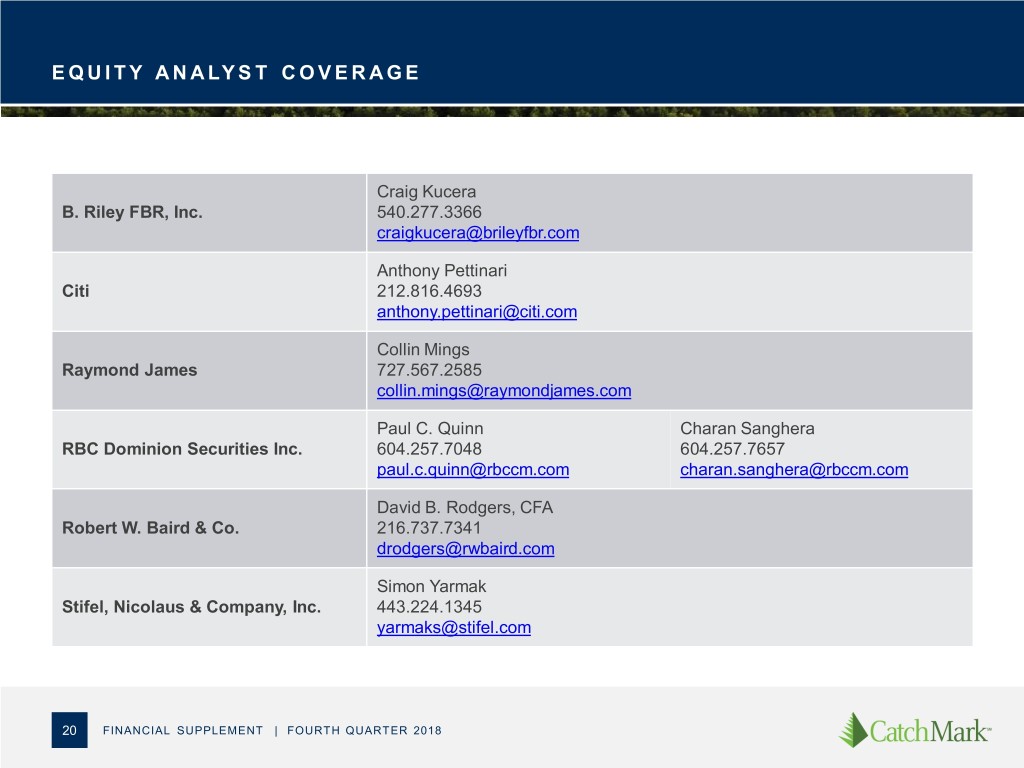
EQUITY ANALYST COVERAGE Craig Kucera B. Riley FBR, Inc. 540.277.3366 craigkucera@brileyfbr.com Anthony Pettinari Citi 212.816.4693 anthony.pettinari@citi.com Collin Mings Raymond James 727.567.2585 collin.mings@raymondjames.com Paul C. Quinn Charan Sanghera RBC Dominion Securities Inc. 604.257.7048 604.257.7657 paul.c.quinn@rbccm.com charan.sanghera@rbccm.com David B. Rodgers, CFA Robert W. Baird & Co. 216.737.7341 drodgers@rwbaird.com Simon Yarmak Stifel, Nicolaus & Company, Inc. 443.224.1345 yarmaks@stifel.com 20 FINANCIAL SUPPLEMENT | FOURTH QUARTER 2018
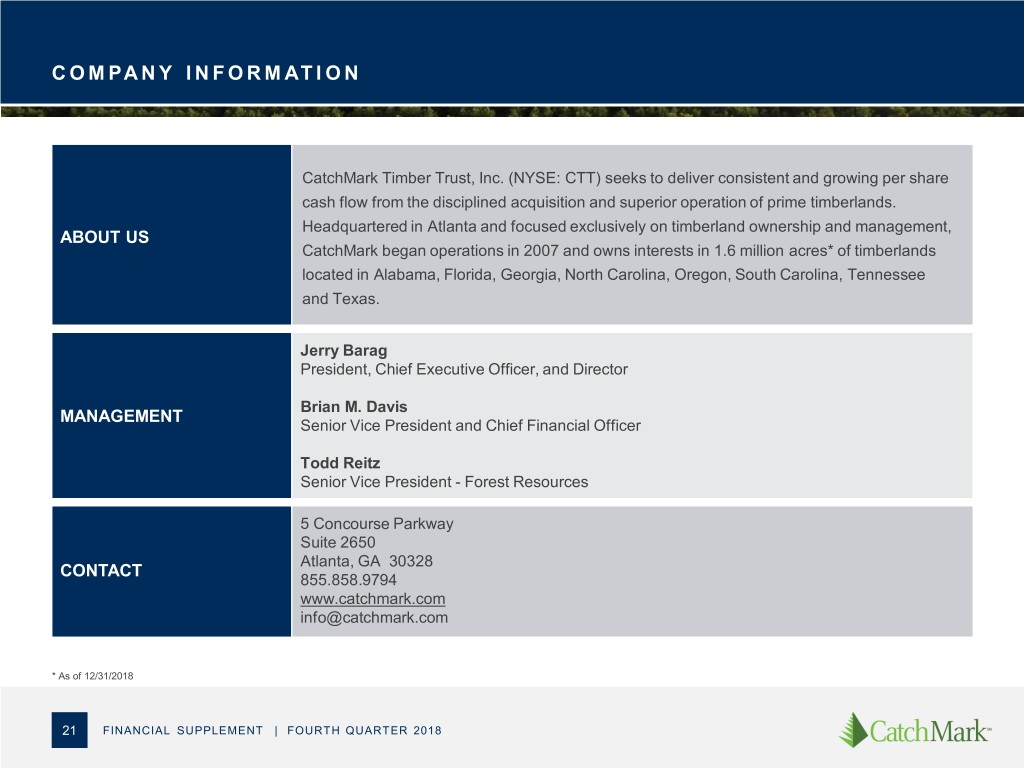
COMPANY INFORMATION CatchMark Timber Trust, Inc. (NYSE: CTT) seeks to deliver consistent and growing per share cash flow from the disciplined acquisition and superior operation of prime timberlands. Headquartered in Atlanta and focused exclusively on timberland ownership and management, ABOUT US CatchMark began operations in 2007 and owns interests in 1.6 million acres* of timberlands located in Alabama, Florida, Georgia, North Carolina, Oregon, South Carolina, Tennessee and Texas. Jerry Barag President, Chief Executive Officer, and Director Brian M. Davis MANAGEMENT Senior Vice President and Chief Financial Officer Todd Reitz Senior Vice President - Forest Resources 5 Concourse Parkway Suite 2650 Atlanta, GA 30328 CONTACT 855.858.9794 www.catchmark.com info@catchmark.com * As of 12/31/2018 21 FINANCIAL SUPPLEMENT | FOURTH QUARTER 2018